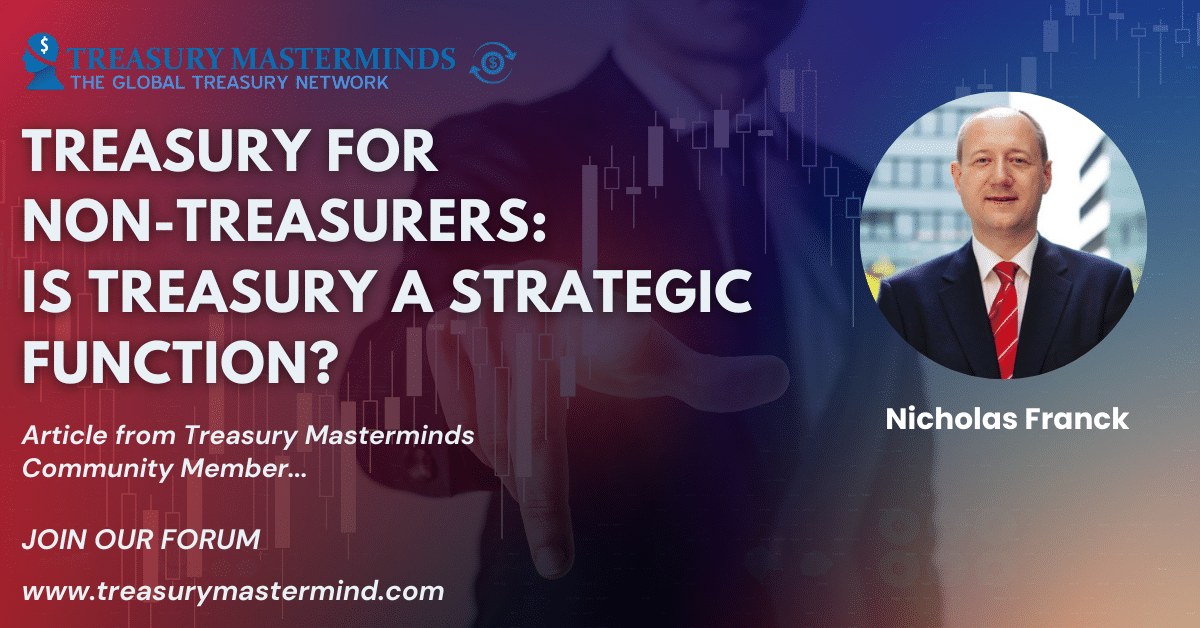
We closed last week with the question:
“Is Treasury a strategic function?”
Ask 1,000 treasurers the question, 999 will say “Yes”. 🙄
I’m being unkind. There is no agreed definition of ‘strategic,’ so every function is strategic in some way or another. Let’s tighten that up. Here’s my definition: “A strategic Treasury:
1. Is one whose focus is on value-add for itself and, more importantly, for more than itself. It’s willing to have worse results if the results of the company or those of customers, suppliers, or anyone in the value chain increase more than the Treasury losses (or extra work and costs.)
2. Is proactive. It puts forward ideas for value creation without needing to be asked by higher management or other functions.
3. Differentiates itself from an operational treasury, which processes and is generally reactive, and from a tactical treasury, which, although still mainly a processing function, does innovate to some extent but only to improve its results, not others’.
4. (and this one might be surprising) Is one that has lower-level functions within it that are at the tactical and operational levels. Dreams without the ability to deliver are useless.”
Many of you will find it unlikely that such functions exist. 😏 I respectfully disagree and thank one of my first bosses at IBM, Ray Pillai, and ABB and Nokia at the height of their success for showing me that they do. 👏 I was fortunate enough to help build IBM’s first Regional Treasury Centre, so I saw it develop from nothing into a world-class operation.
Are many Treasuries strategic according to this definition?
Answer: No, in fact, very few are.

Trying to put some figures on this, research on the diffusion of innovation (a key requirement for proactivity) suggests that 2.5% of an average set of people or organisations are innovators. But Treasury operates within and surrounded by finance, a necessarily conservative environment, and many of its participants have an accounting background, where, again, necessarily, they are trained to be conservative. Many also operate within company and country cultures that don’t encourage risk-taking and bottom-up proactivity. For any of these reasons and more – that we will talk about in later articles – a much smaller figure is likely to be correct. In my experience, less than 1% of organisations meet all the criteria above.
Early adopters are supposed to be 13.5% of the population. I think I think this figure for Treasury organisations that meet many but not all criteria is more likely to be between 5 and 10% for the same reasons. The rest (early majority, [34%+], late majority [34%+], and laggards [16%+] go from being tactical treasuries to operational ones.
Note that these are high-level numbers, and if you concentrate on an individual Treasury, it can be the exception that proves the rule. Also, Treasury project teams and sub-functions can have different orientations. And all these can change at times and over time: If external cultures, context, material adverse impacts (‘Black Swans’), significant needs, key personnel or other aspects change, so does the Treasury orientation. Some become more strategic, some less. At a higher level, though, the numbers probably don’t change that much. Some go up and some down. Long-term, truly innovative Treasuries are rare, and so are fast followers.
Working with strategic Treasuries
These strategic Treasuries are the trendsetters. They are the customers that suppliers work with when developing new products. They face problems and learn how to control undesirable aspects of cutting-edge products. If they innovate frequently, they become good at spotting undesirable elements in advance and managing them.
Other Treasuries don’t. Seduced by tales of success by others, they buy products and services but don’t realise the dangers until it’s too late. Current example: As Treasuries become increasingly automated, who’s left to design and implement change in a crisis?
Why should non-Treasurers care?
So, OK, it’s clear why a treasurer might care. But why should a non-treasurer care? Answer: Because a strategic Treasury will initiate change for the benefit of the whole organisation, working for you, the non-treasurer, and for those who will deliver maximum benefits for the company. As we’ll see in the next article, these benefits are substantial and translate into better financial results, freer budgets, and happier work environments. And best-in-breed Treasuries can communicate effectively with you in your language. You don’t have to add ‘gain treasury expertise’ to your list of priorities.
Tactical Treasuries also work well with others. But they will not initiate. And they won’t be the driving force for improvement. They don’t add as much value as strategic Treasuries but instead help you achieve it. They are more business partners than value-added functions.
How can you tell if a Treasury operation is strategic?
Over time, non-treasurers see this difference. Non-treasurers realise they get more value out of strategic Treasuries – and vice-versa. Strategic Treasuries accumulate political capital, which translates into more staff, bigger budgets, and more opportunities for value-add.
This last point is a big ‘tell’ for non-treasurers – like a poker tell that tells you what cards the player is holding. How do you recognise strategic or tactical Treasuries from the outside looking in? Look for those with large staff, resources and budgets compared to similar organisations or other back-office functions in the same organisation. The staff will seem happier and more motivated. They will be more flexible. They will try to see situations from your point of view. These are the strategic and tactical Treasuries.
And remember:
They do exist.
Next article: What’s Treasury’s impact on business performance?
To read the first series of this article, please check: Treasury for Non-Treasurers: What is Treasury?
Join our Treasury Community
Treasury Masterminds is a community of professionals working in treasury management or those interested in learning more about various topics related to treasury management, including cash management, foreign exchange management, and payments. To register and connect with Treasury professionals, click [HERE] or fill out the form below to get more information.